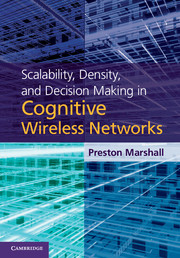Book contents
- Frontmatter
- Contents
- Preface
- Part I Overview
- 1 Introduction
- 2 Theoretical foundations
- 3 Future wireless operation, environments, and dynamic spectrum access
- 4 Some fundamental challenges in cognitive radio and wireless network systems
- Part II Generalized environmental characterization
- Part III System performance of cognitive wireless systems
- Part IV Integrated awareness and decision making
- Part V Summary
- Part VI Appendices
- Index
- References
3 - Future wireless operation, environments, and dynamic spectrum access
from Part I - Overview
Published online by Cambridge University Press: 05 December 2012
- Frontmatter
- Contents
- Preface
- Part I Overview
- 1 Introduction
- 2 Theoretical foundations
- 3 Future wireless operation, environments, and dynamic spectrum access
- 4 Some fundamental challenges in cognitive radio and wireless network systems
- Part II Generalized environmental characterization
- Part III System performance of cognitive wireless systems
- Part IV Integrated awareness and decision making
- Part V Summary
- Part VI Appendices
- Index
- References
Summary
Overview
This chapter provides an overview of the growth of wireless architectures that are challenged in terms of both capacity and density spectrum density, and outlines general options for addressing these challenges. One of the premises of this book is that the challenge of operating in dense spectrum will fundamentally change the nature of wireless operation for all spectrum-dependent systems, and that these changes will both require new technology (control, coordination, and decision making as examples) and create new opportunities to fundamentally extend the capabilities of wireless systems, ultimately to the point of comparability with wired delivery modes.
Although this book is not specifically about implementation of dynamic spectrum access (DSA), many of the techniques it describes assume DSA features will be present in future wireless systems. This is not an unreasonable assumption, insofar as both regulatory acceptance and technical necessity would appear to support this spectrum-access modality, for all emerging spectrum applications. DSA has many advantages in terms of enabling increased use of the spectrum, but it is also enabling for even more significant changes in wireless network operation, including the ability of nodes to mitigate interference to themselves from other nodes, locate frequencies with optimal propagation to achieve network density, and manage modulation and bandwidth.
Much of the DSA research literature focuses on achieving interference-free operation. Here, we will use the flexibility provided by DSA to manage a node's own environment.
Information
- Type
- Chapter
- Information
- Publisher: Cambridge University PressPrint publication year: 2012
